Overview
This year, I decided to spend some time in Colombia, South America, making this the 85th country I’ve visited. As I embarked the Avianca plane in Bogotá to travel to the city of Cali, I racked my brain trying to work out why I was going there?!. Cali isn’t globally known as a standout tourist destination. I’ve never met anyone who had been there! It doesn’t make the news. Few people could find it on a map. That’s never stopped me before, though, as I’ve been to hundreds of places off the beaten track, although I note they’re becoming more popular as travel accelerates. In my brief time in Cali, I was so glad I went. I ended up really enjoying the place and was sad to leave.
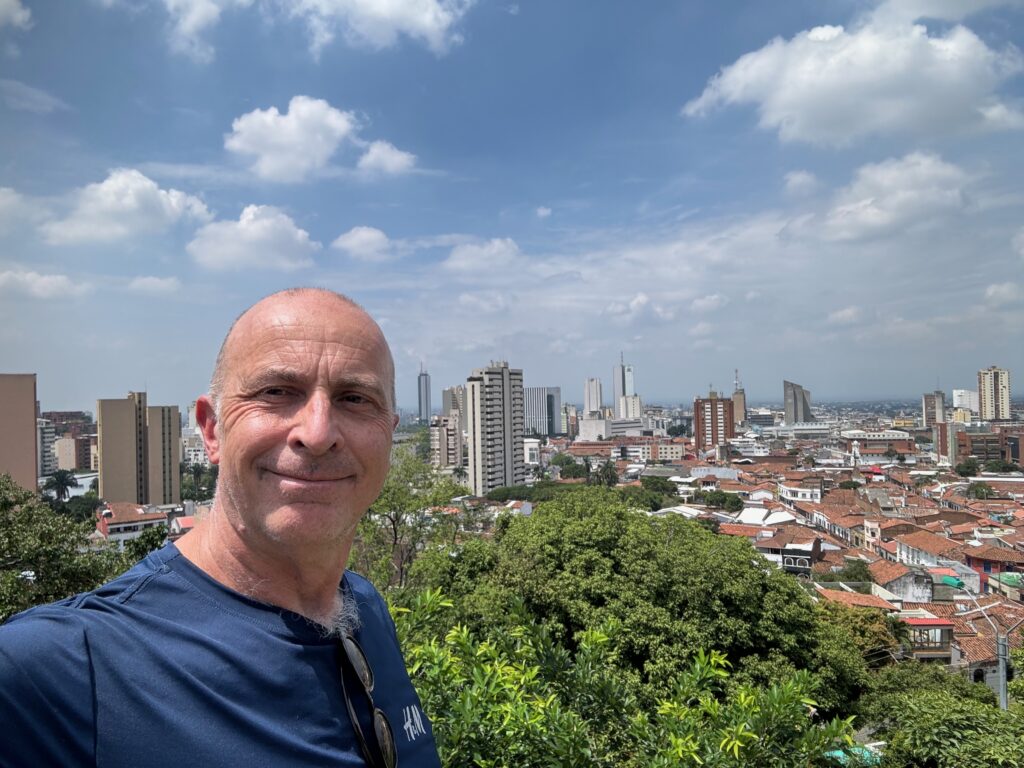
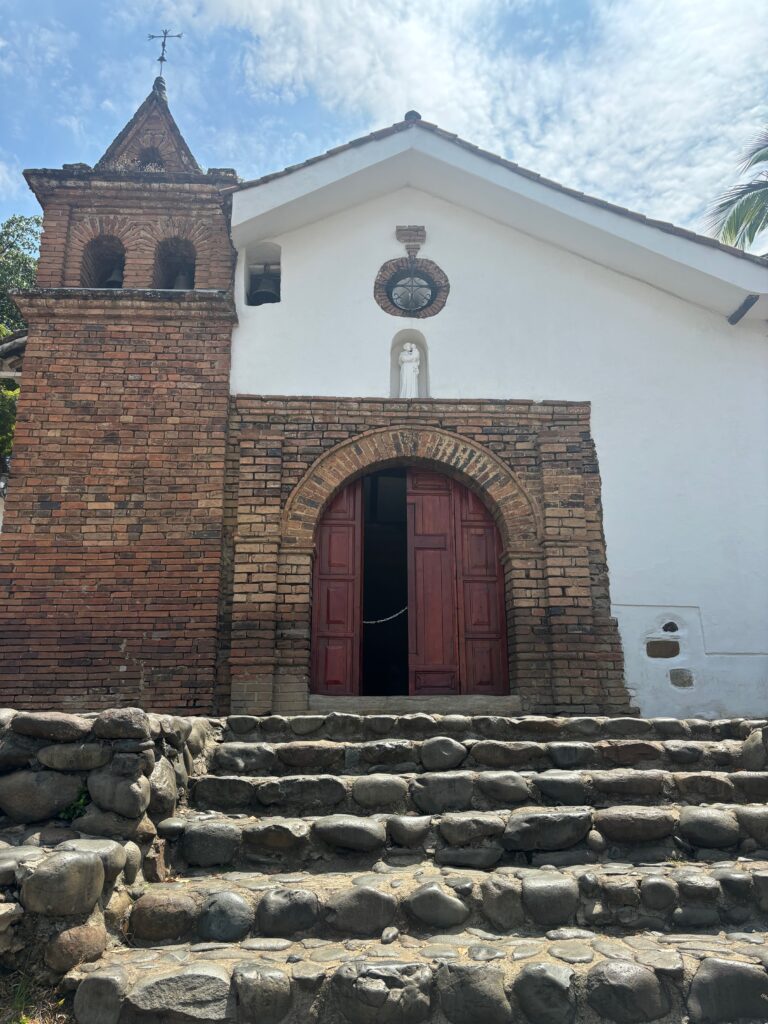
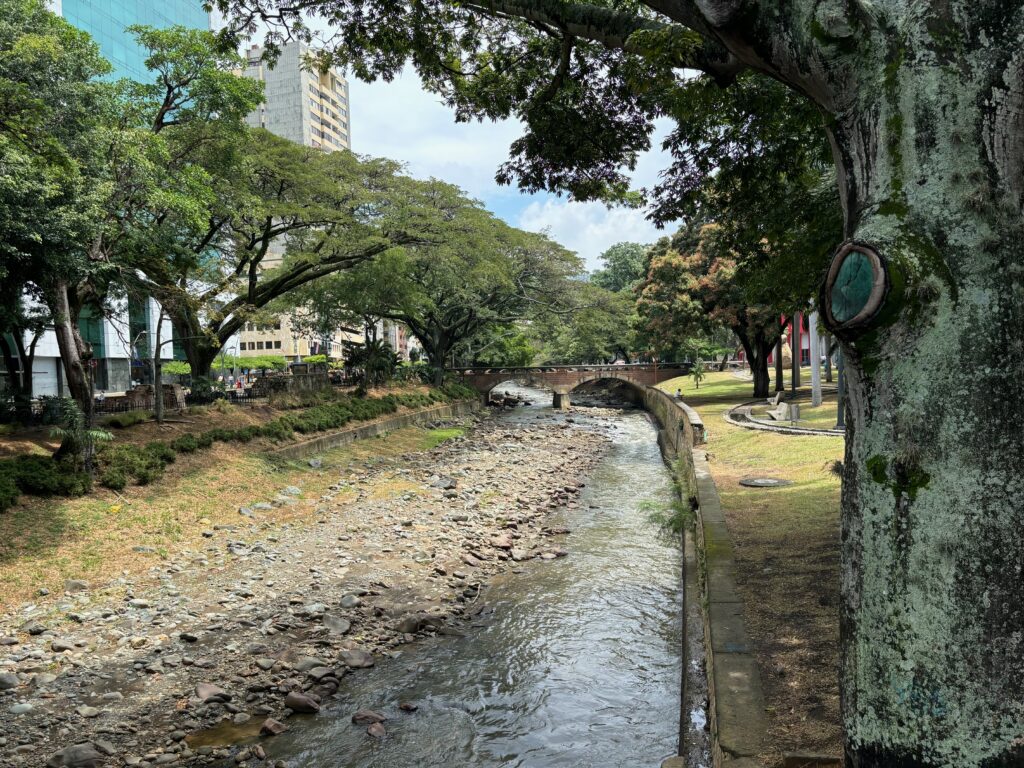
- My Overall Rating: 78%
- My Ranking out of my top 244 Cities: 115th place. If the crime rate was lower, it would be in the top 50
- Why it should be visited: World-famous salsa scene, rich Afro-Colombian culture, and year-round warm weather.
- Negatives: Traffic congestion, uneven infrastructure, and a high crime rate in certain areas.
- Would I return?: Yes, Yes, Yes.

Location and Orientation
Cali, officially known as Santiago de Cali, is the capital of Valle del Cauca in western Colombia. It is situated in the picturesque Cauca Valley, surrounded by lush sugarcane fields and framed by the towering Western and Central Cordilleras of the Andes. The city’s landscape is stunning, and the sugarcane smell as I travelled from the airport to downtown was both nostalgic and exotic. Nostalgic because it evoked memories of my childhood experiences in a small Australian sugarcane community, and exoctic because no other major city I have been to has had this smell! sweet, earthy scent.
Sebastián de Belalcázar, a Spanish conquistador founded Santiago de Cali (commonly known as Cali) on July 25, 1536. He established the city as a strategic location in the Cauca Valley, intending to secure Spanish control over the region and facilitate further conquests. Cali’s fertile land and proximity to important rivers made it ideal for settlement and expansion. Today, Cali is one of Colombia’s leading industrial and commercial centres focused on sugar, textiles, and pharmaceuticals.
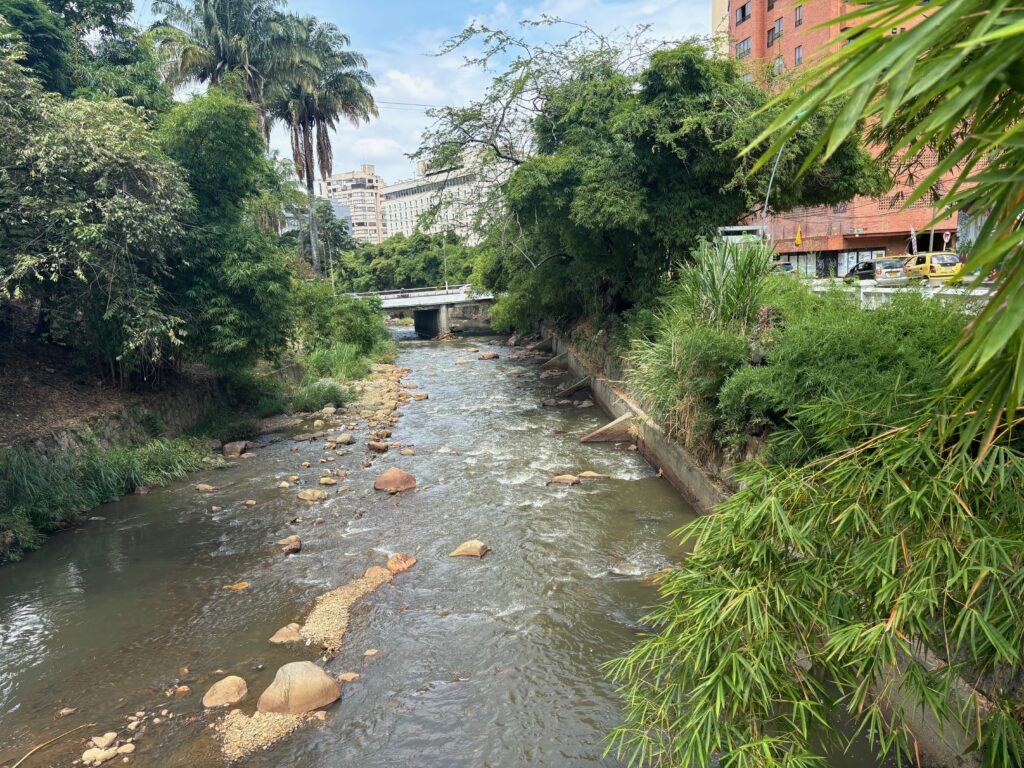
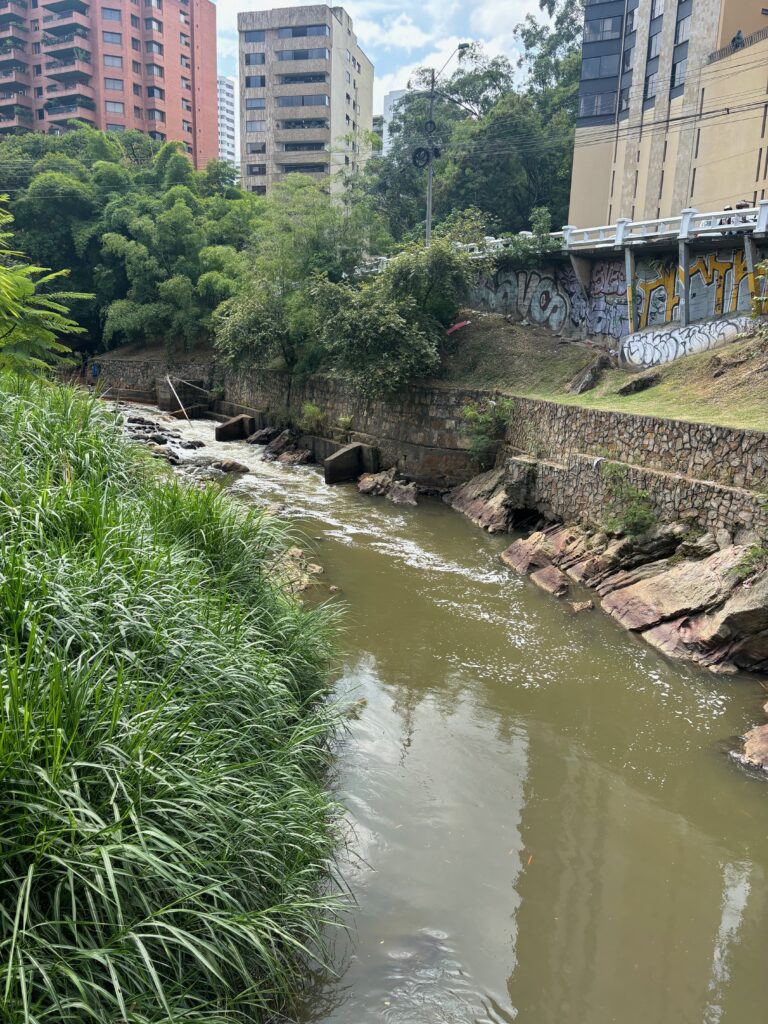
Cali spans 619 square kilometres (239 square miles), almost the same size as Boston, Massachusetts. and slightly smaller than the island of Sinagpore. It is home to around 2.2 million residents called called Caleños. The greater metropolitan area houses over 3 million people, making it the third-largest city in Colombia. Cali’s urban structure is organised around the banks of the Cali River, which flows from west to east through the city. In addition to the Cali River, the city is intersected by several other rivers, such as the Aguacatal, Lili, Meléndez, and Cañaveralejo rivers, contributing to its distinctive layout and natural beauty.
Vibe
Cali, known as the “Salsa Capital of the World,” is famous for its lively nightlife and passionate dance culture. Salsa music and dance are deeply embedded in the city’s identity, and it hosts the renowned World Salsa Festival, attracting dancers from all over the globe. The energy of Cali is palpable, with music filling the streets and clubs every night.
Beyond its music, Cali is also a hub for sports, particularly athletics, football (soccer), and cycling. The city has a strong tradition of producing top-tier athletes who have excelled nationally and internationally.
Cali hosted the 1971 Pan American Games, and the Pascual Guerrero Olympic Stadium remains one of the most prominent sports venues in the city. National sporting events are regularly held in the city, solidifying its status as a centre for athletic achievement.
Cali’s cultural richness extends beyond sports and salsa. The city is home to various theatres, museums, and art galleries.
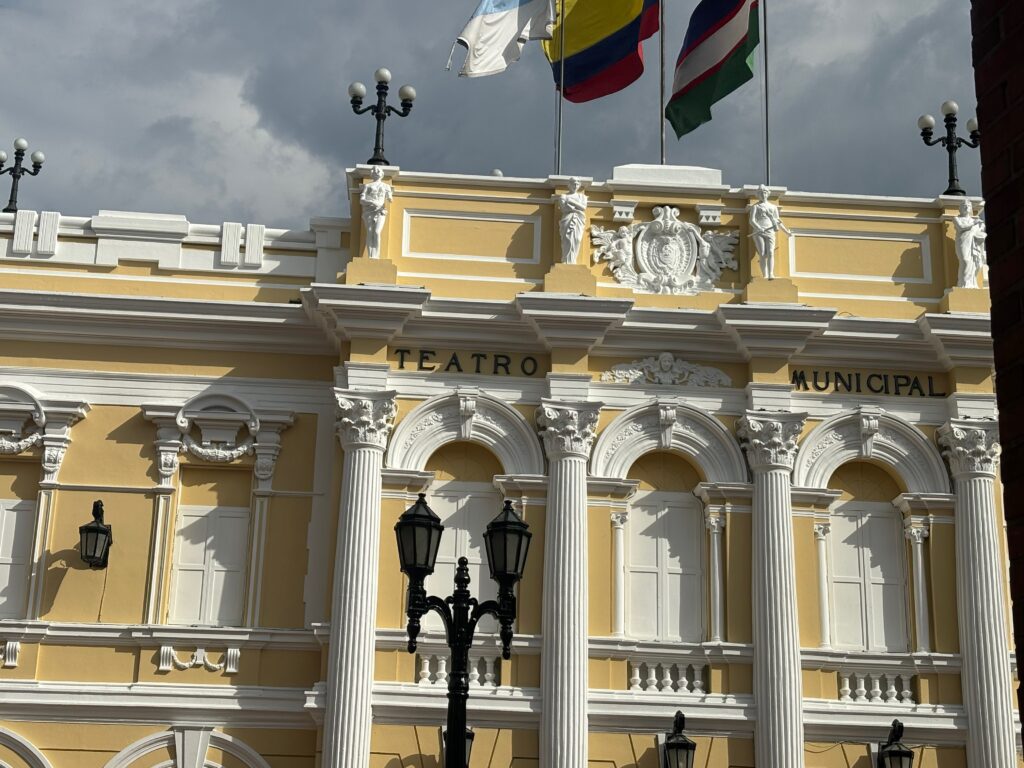
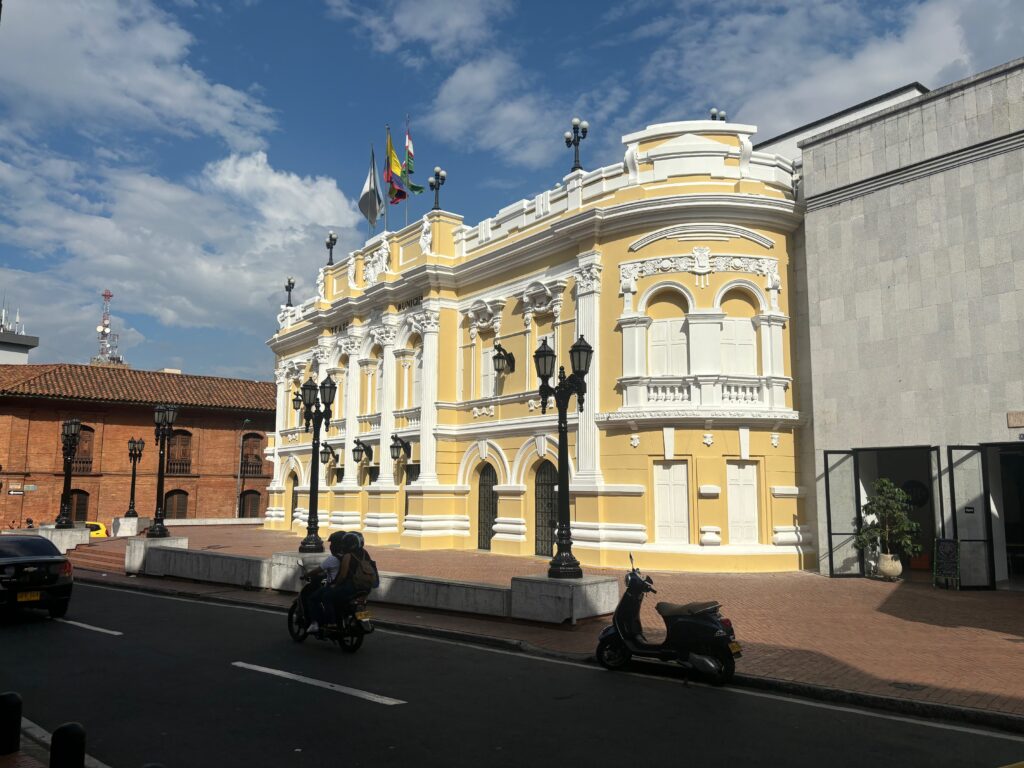
It does not have the polished appeal of some major global cities but I found charm lies in its incredibly welcoming locals, beautiful rivers, temperate climate natural surroundings make it a captivating destination that leaves a lasting impression on visitors. To me, Cali offered a rhythm, culture, and energy that I lapped up.
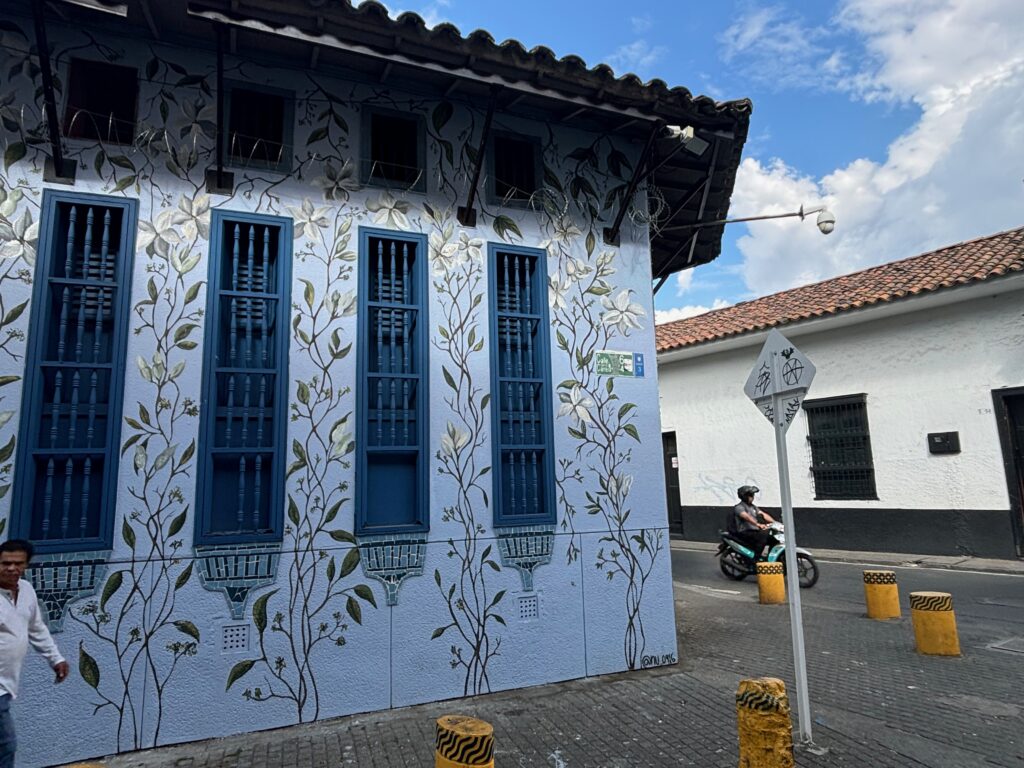
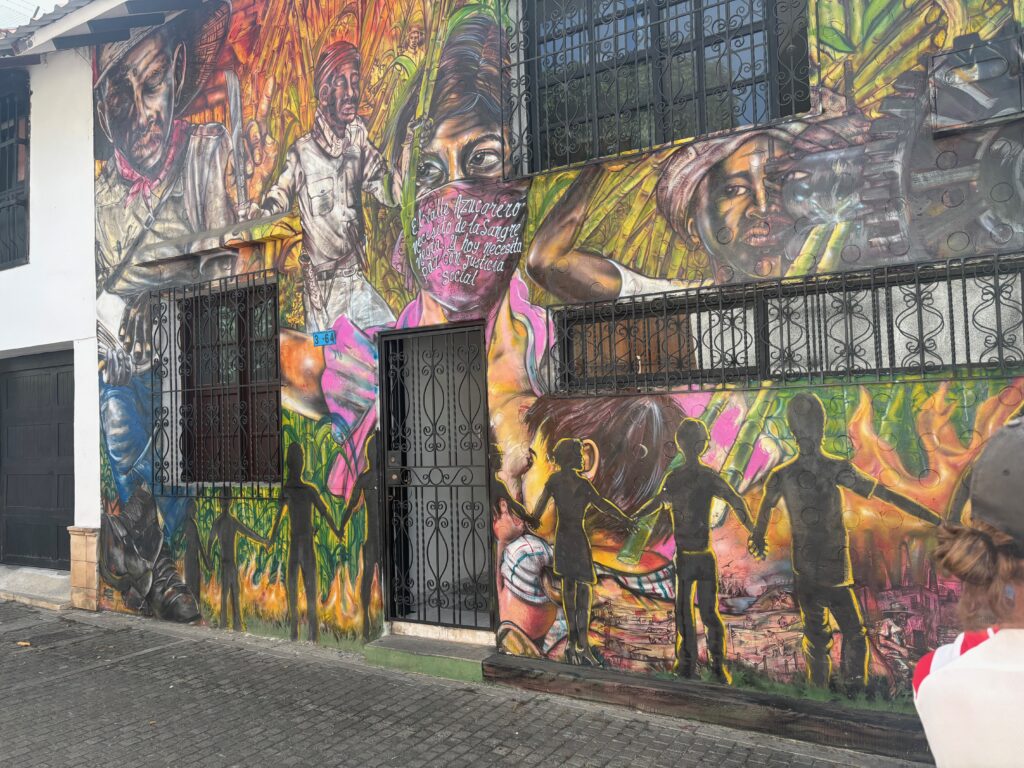
Getting There
The city’s strategic location, with access to both the Pacific coast and major inland cities, makes it a crucial logistics hub. Cali is connected by non-stop flights to:
- Latin America: Aruba (Wingo), Panama City (Copa), Quito (Weekly-Aeroregional,), Santiago (Jetsmart) and São Paulo.
- The USA: Miami (American and Spirit), New York City (Avianca), and Fort Lauderdale (Spirit).
- Domestic Colombia: Bogotá, Medellín, Cartagena, and San Andrés.
Cali’s Alfonso Bonilla Aragón International Airport sits at 964 meters (3,163 feet) above sea level and is located about 15 kilometers (9 miles) northeast of the city centre. Plenty of taxis available at the airport although I booked an Uber in both directions. There is a bus from the airport (CLO) every 30 minutes to Cali’s Main Transportation terminal. It takes around an hour.
Long-distance buses connect Bogotá, Medellín, and other cities, including Cali, with travel times dependent on the terrain and road conditions. For instance, Pan-American Highway (Route 25) which is the road from Bogotá to Cali is known for its twists, turns, and significant changes in elevation due to the Andes mountains. The distance between Bogotá and Cali is approximately 464 kilometres (288 miles), and I was shocked to find out that buses typically take around 10-12 hours to complete this journey, depending on the traffic, road conditions, and weather because of the mountainous roads. The road to Medellín is shorter and less mountainous than the road to Bogotá. Both roads have stunning scenery.
There are freight rail lines connecting Cali to the port of Buenaventura, Colombia’s main port on the Pacific coast but the rail system is no longer operational for passenger services,
Getting Around: 74%
Cali is divided into 22 communes, each containing multiple neighbourhoods or “barrios,” which reflect the city’s diverse socio-economic and cultural landscape. Some of the most well-known areas include:
- City Center (Centro): Located near the river, this area is home to many of Cali’s historic landmarks and is a central business district. The streets are filled with a mix of commercial activity, government buildings, and historical sites.
- Granada (Comuna 2): Renowned for its vibrant dining and nightlife scene, Granada is a bustling hub for food lovers and those looking to experience Cali’s energetic social atmosphere.
- El Peñón (Comuna 3): This district is a blend of old and new, mixing traditional and contemporary architecture. It’s home to art galleries, boutique hotels, and upscale restaurants, making it a trendy yet historic part of the city.
- San Antonio (Communa 3): This historic area, one of the oldest in Cali, is famous for its colonial architecture, bohemian vibe, and lively art scene. It’s a favourite among tourists and locals alike for its cobbled streets, bohemian cafes, art galleries, and live music venues, and panoramic views from San Antonio hill.
- Ciudad Jardín (Comuna 19): A modern, upscale neighbourhood characterized by its greenery, luxury homes, and residential developments. It’s known for being one of the wealthier areas of Cali, offering shopping centres and leisure spaces.
Beyond the central areas, Cali expands into residential zones, with a mix of single-family homes, apartment complexes, and gated communities, parks and recreational areas.
The main mode of public transport is the MIO (Masivo Integrado de Occidente) Bus Rapid Transit system It is not as polished as Bogotá’s TransMileno but quite functional, affordable and relatively efficient. It spans over 100 kilometers (62 miles) with dedicated stations and bus lanes. The system can be crowded, especially during peak hours.
Taxis and Uber operate well and are a convenient alternative, especially late at night.
My Top Sights in Cali
1. San Antonio: I fell in love with this historic neighbourhood that I have mentioned above. The Church the area is named after is well worth the climb up the hill and the park area around it and the views are lovely.
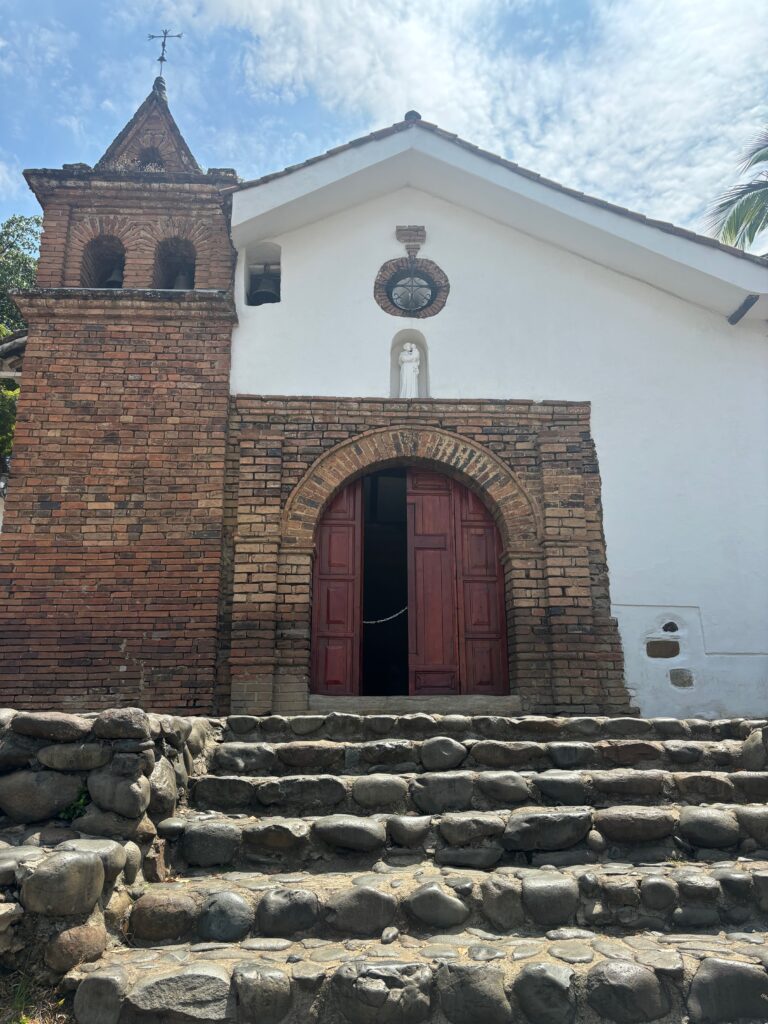
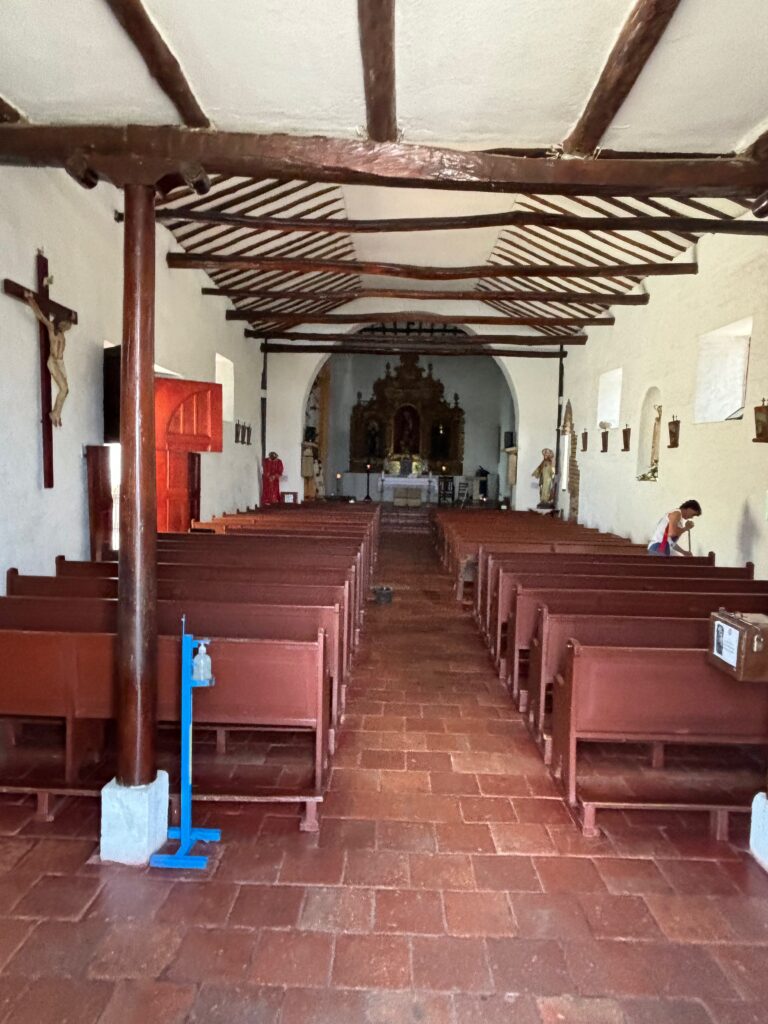
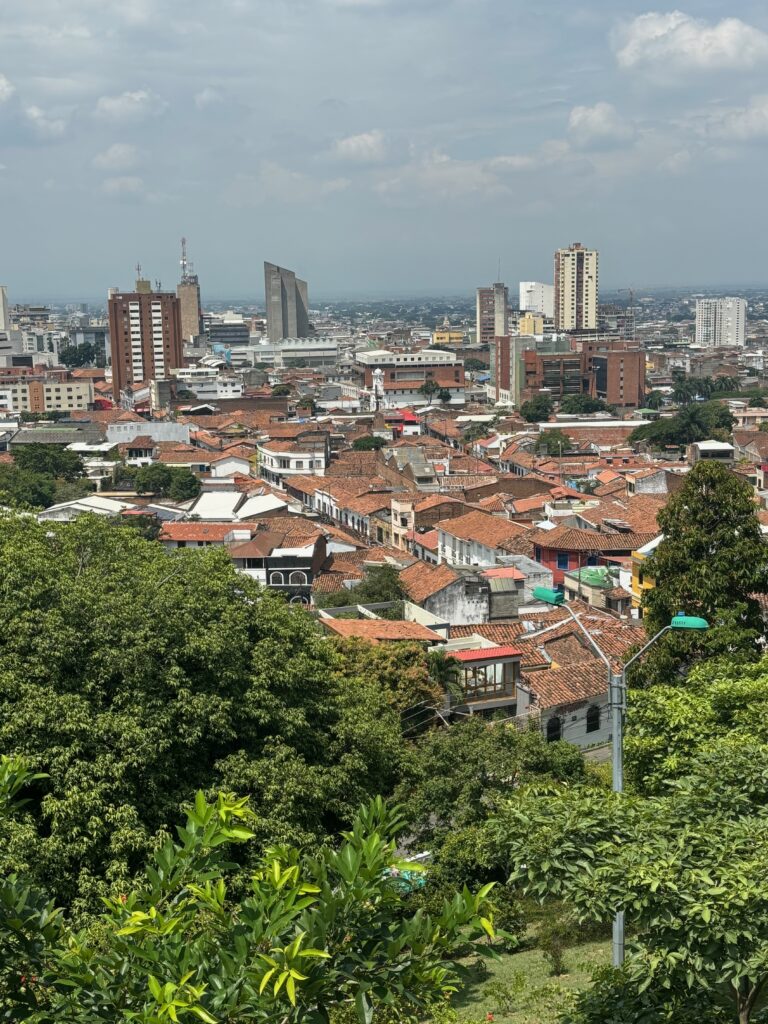
2. El Peñón: A trendy district, slightly beyond San Antonia known for its upscale dining, boutiques, and nightlife. El Peñón is a favourite among locals and expats for its lively atmosphere and array of restaurants offering great quality traditional Colombian cuisine and international flavours. I decided it was the perfect place to spend an evening out.
3. Cali River Walk (Bulevar del Río): I really enjoyed this scenic promenade along the Cali River. It is lined with trees, public art, and cafes, making it a great place to relax and take in the city’s ambiance. Many locals and visitors sitting, chatting, walking, running, and biking here.
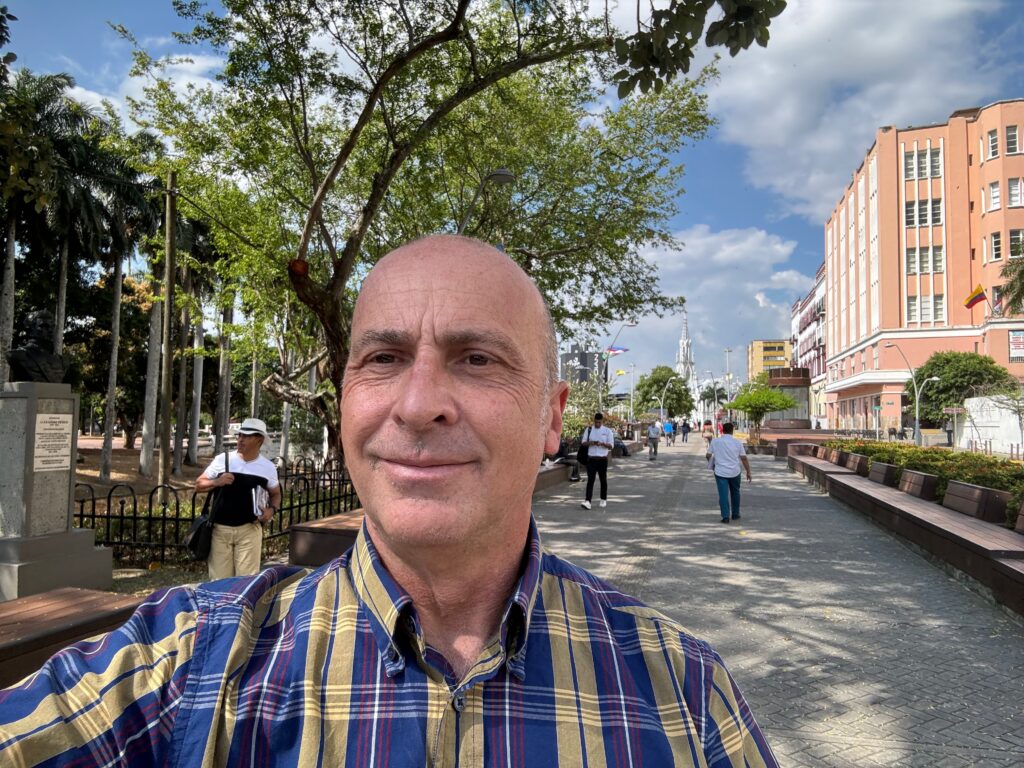
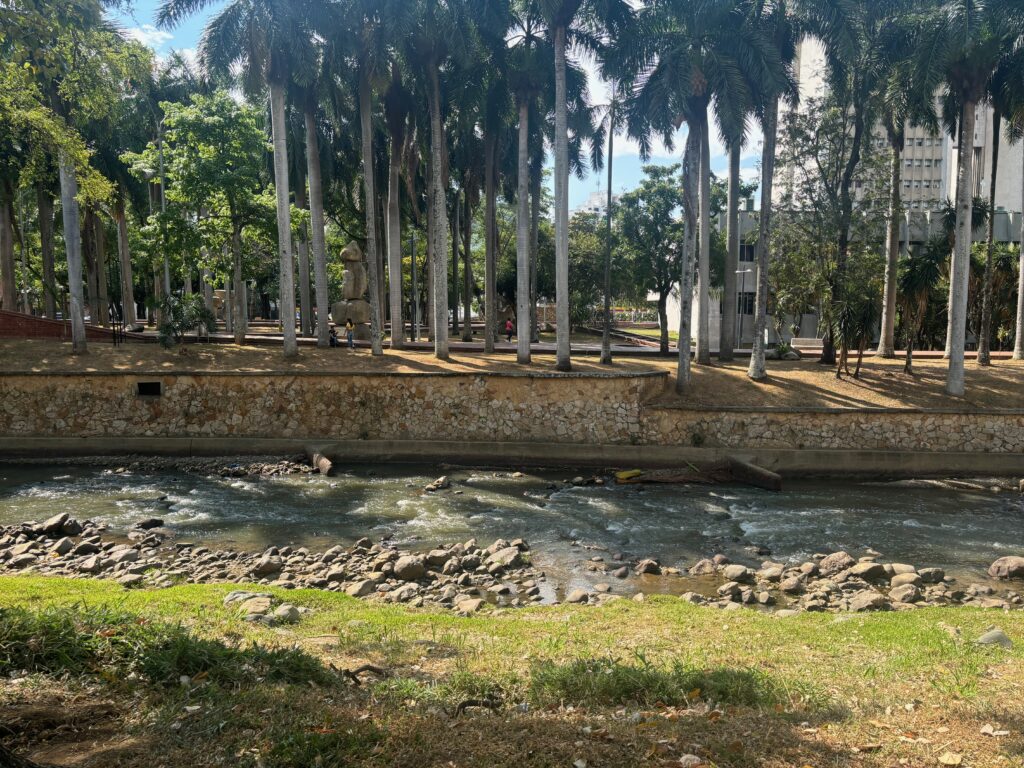
The waterside has a series of cat sculptures including one by the artist Hernando Tejada (not this one below..I just liked it the most!).
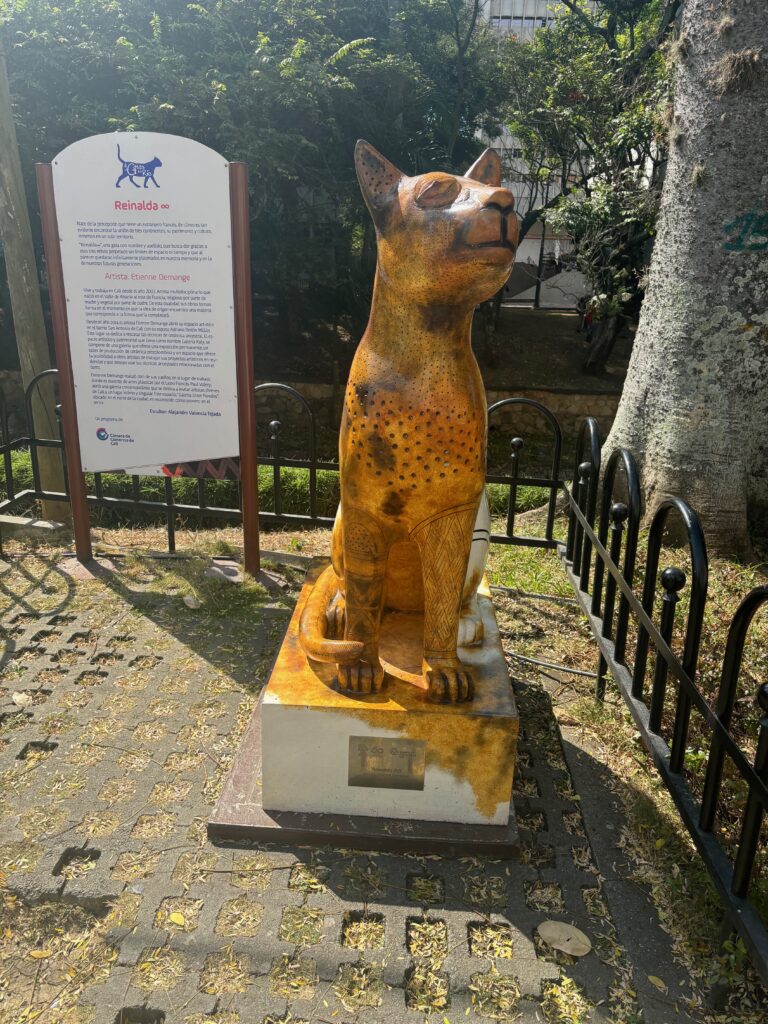
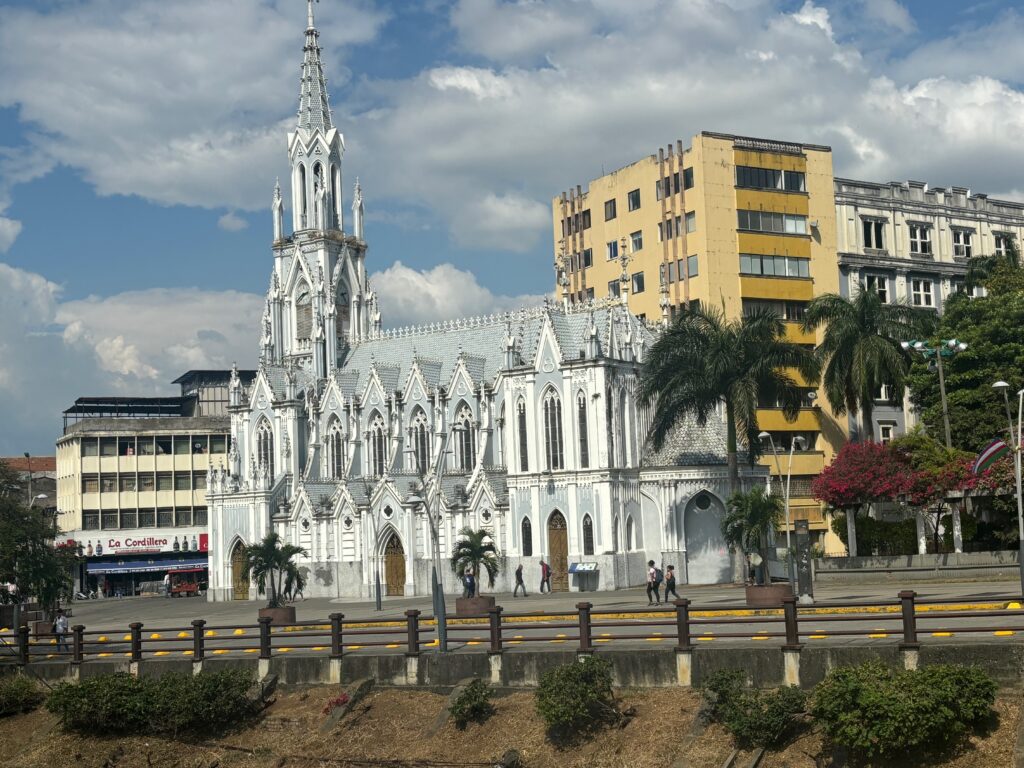
A fascinating landmark is the Gothic-style La Ermita Church, built in the 1930s. It replaced a 17th century structure impacted by an earthquake.
The church’s 18th-century marble altar was brought from Italy, while its musical clock and windows were imported from Amsterdam.
4. Museo La Tertulia: This contemporary art museum is a must. Located along the banks of the Cali River, it features a very enjoyable collection of modern art from both Colombian and international artists.
5. Plaza de Cayzedo: The main square in downtown Cali feels a little run down but is a sfactinatim place to still through, people watch and relax. It is surrounded by important buildings, including the Metropolitan Cathedral.
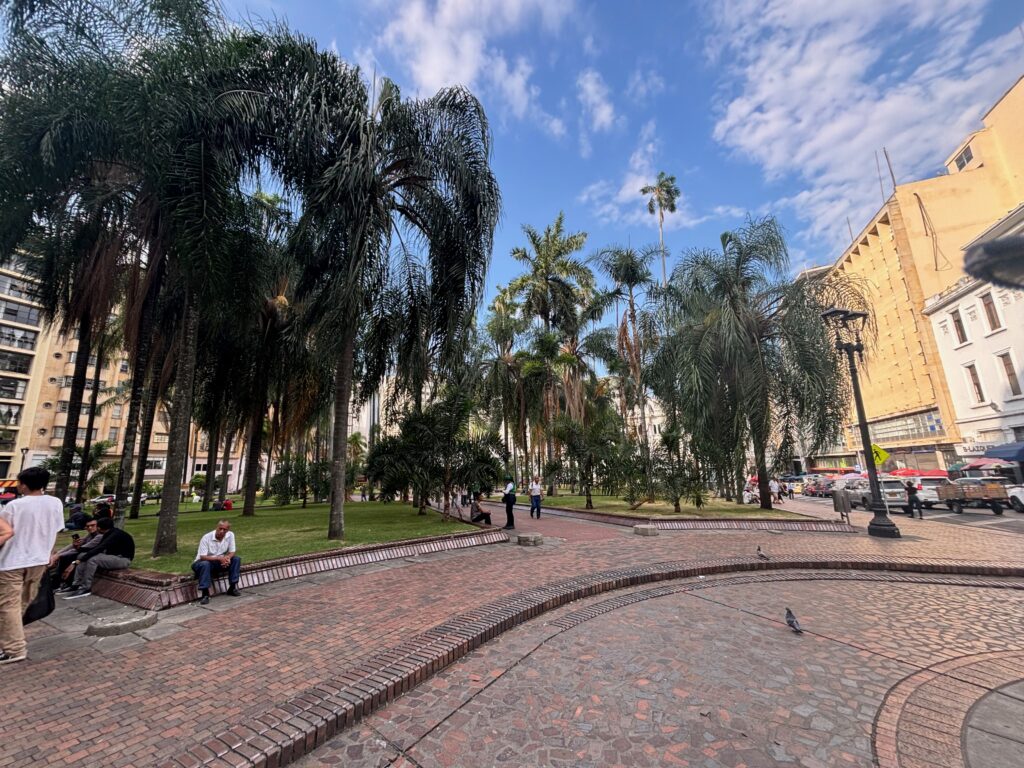
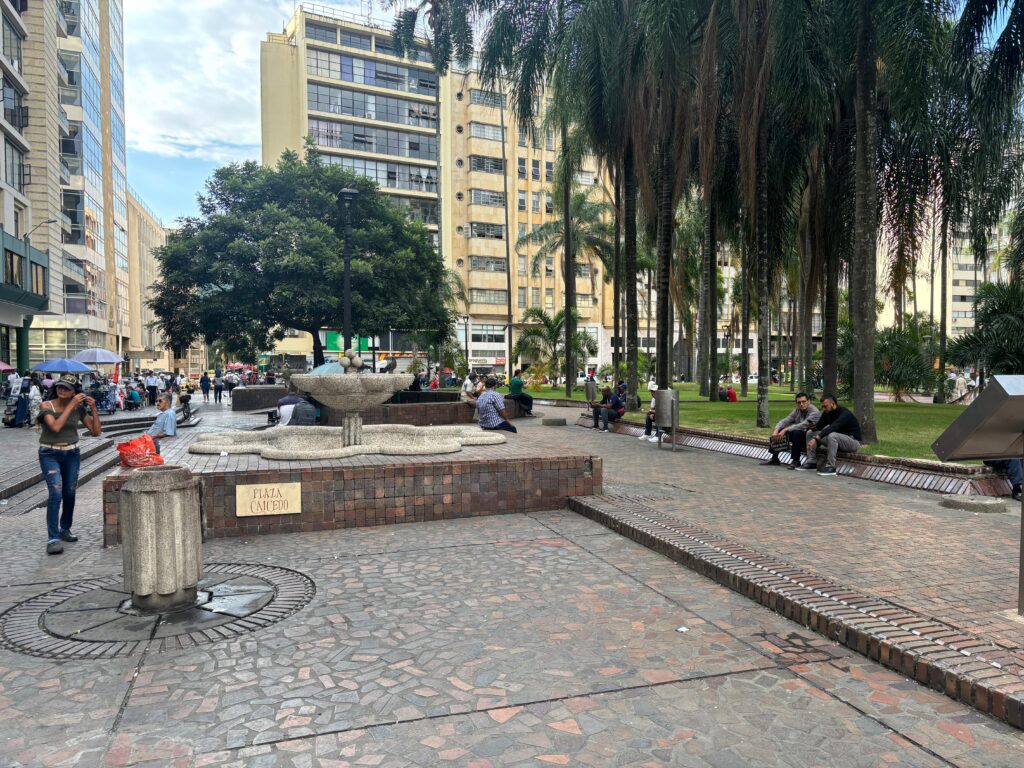
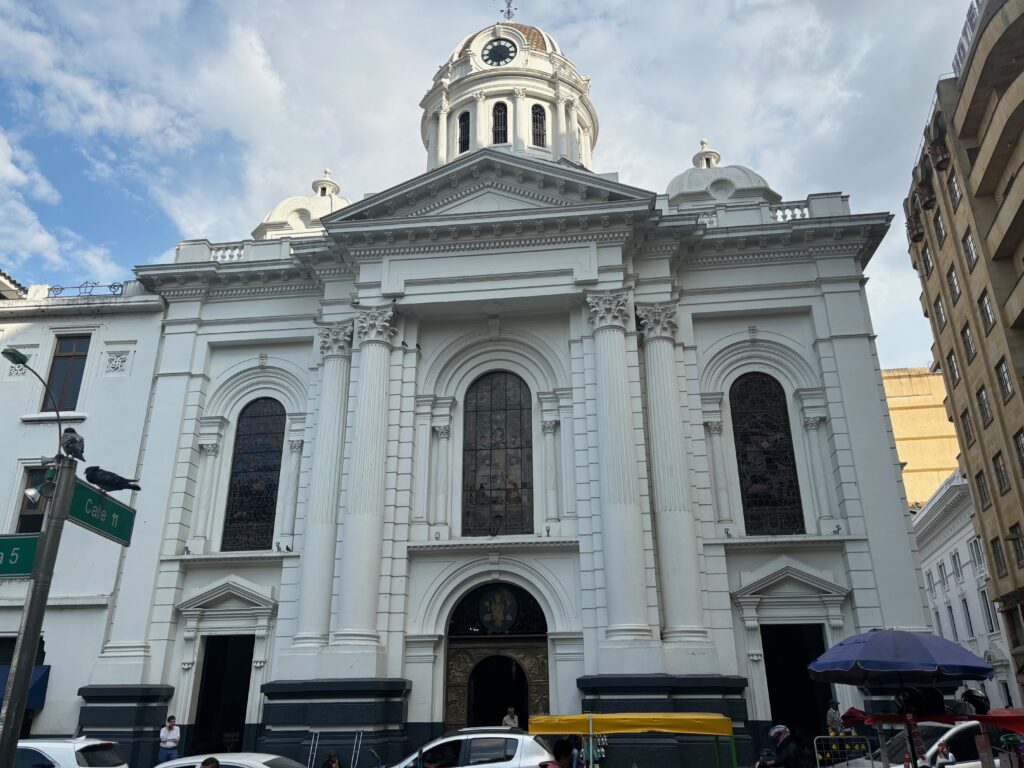
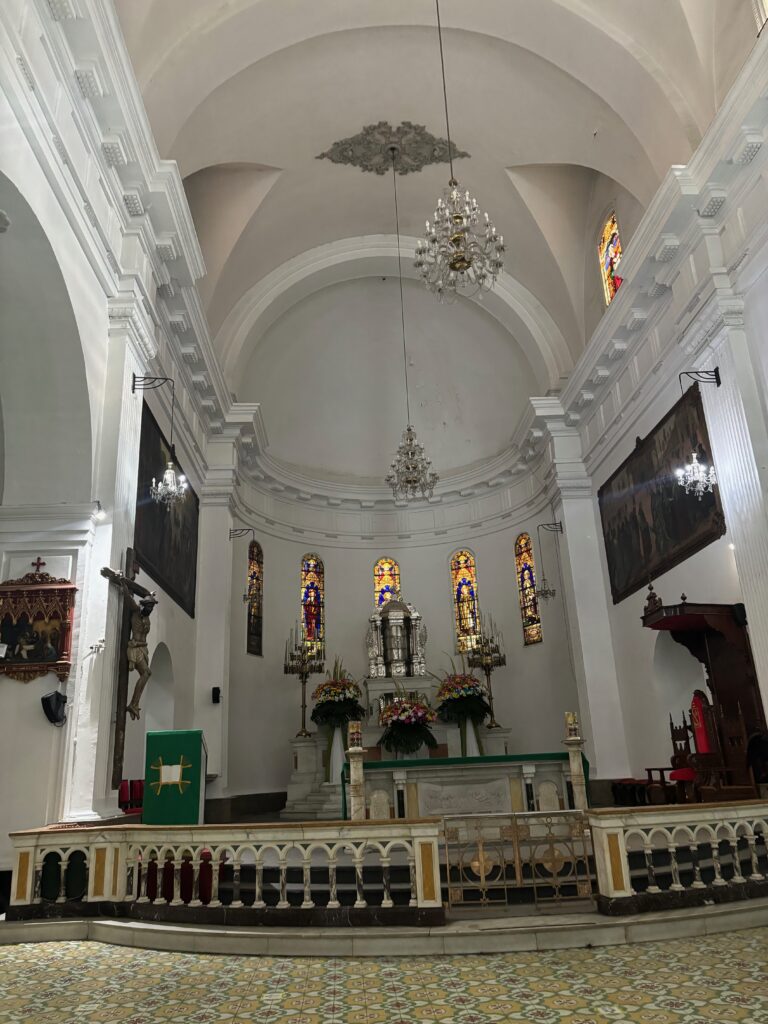
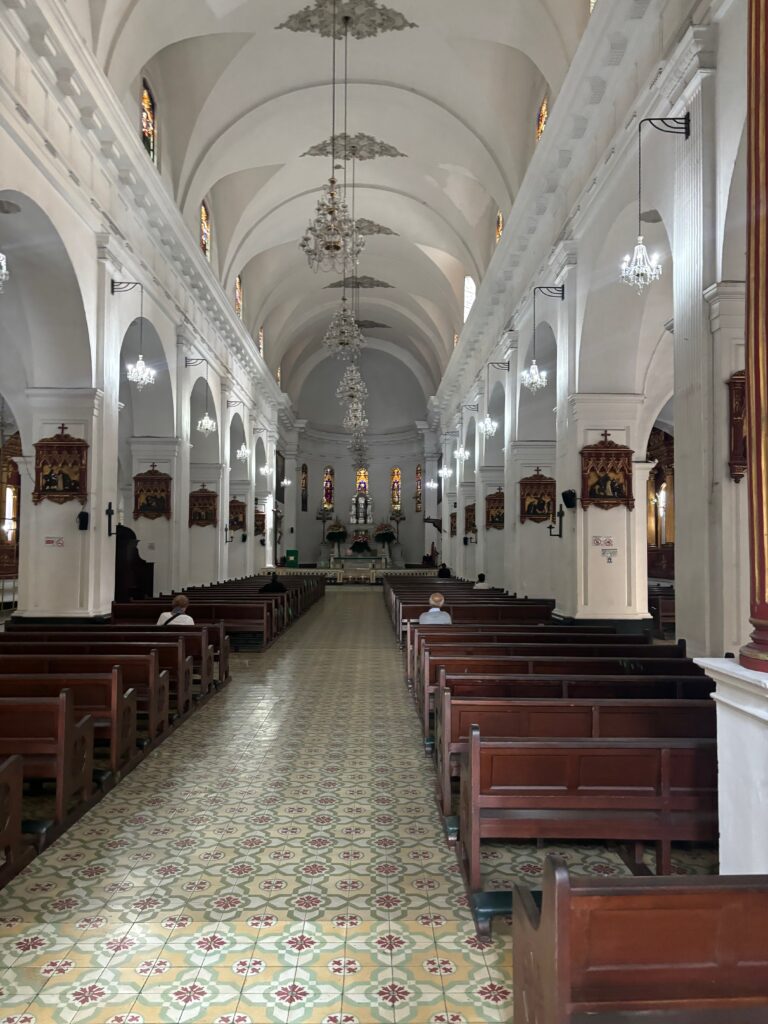
6. Salsa Clubs: As the salsa capital of the world, the city is full of salsa clubs with amazingly skilled dancers putting me to shame. There are lessons available!
7. Orquideorama: A really lovely botanical garden near the Cali River
8. La Merced is one of the most important historical sites in Cali and a must see. It is a colonial complex located in downtown Cali and is considered the city’s birthplace with:
- La Merced Church (Iglesia de La Merced): a beautiful, whitewashed colonial church dates back to the 16th century and is one of the oldest in the city. The first mass in Cali was held here in 1536.
- La Merced Archaeological Museum: This museum is part of the La Merced complex and showcases pre-Columbian artifacts, highlighting indigenous cultures of the Calima and Quimbaya civilizations.
- La Merced Religious Art Museum: This museum displays colonial-era religious art, including Catholic paintings, sculptures, and historical objects.
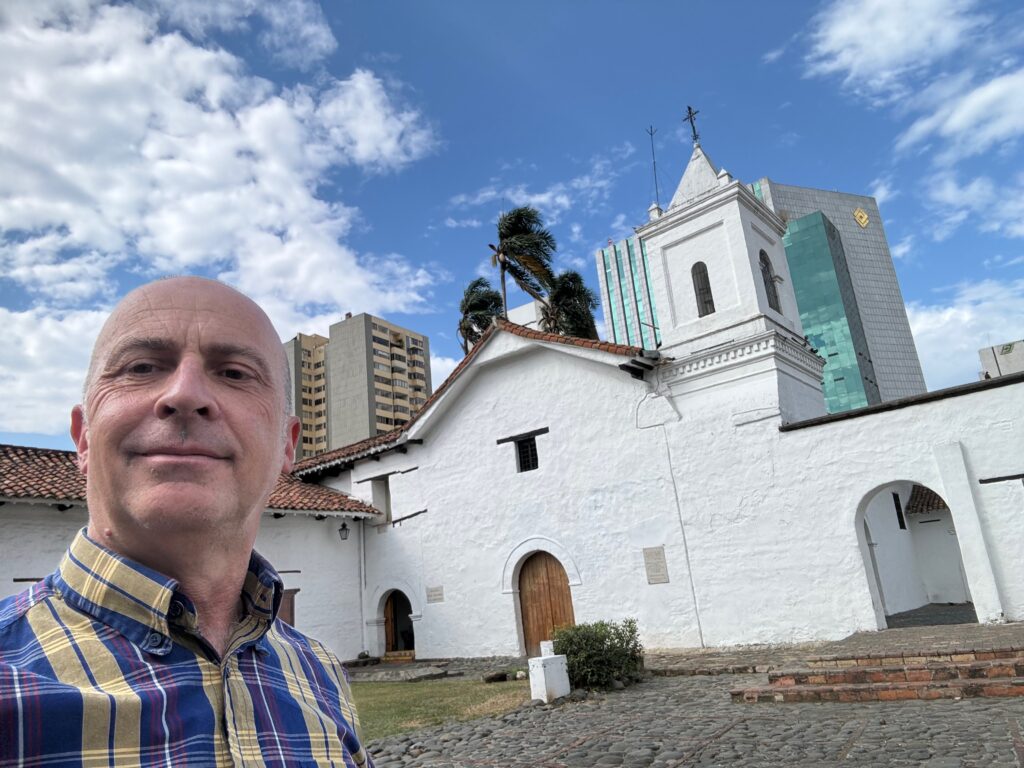
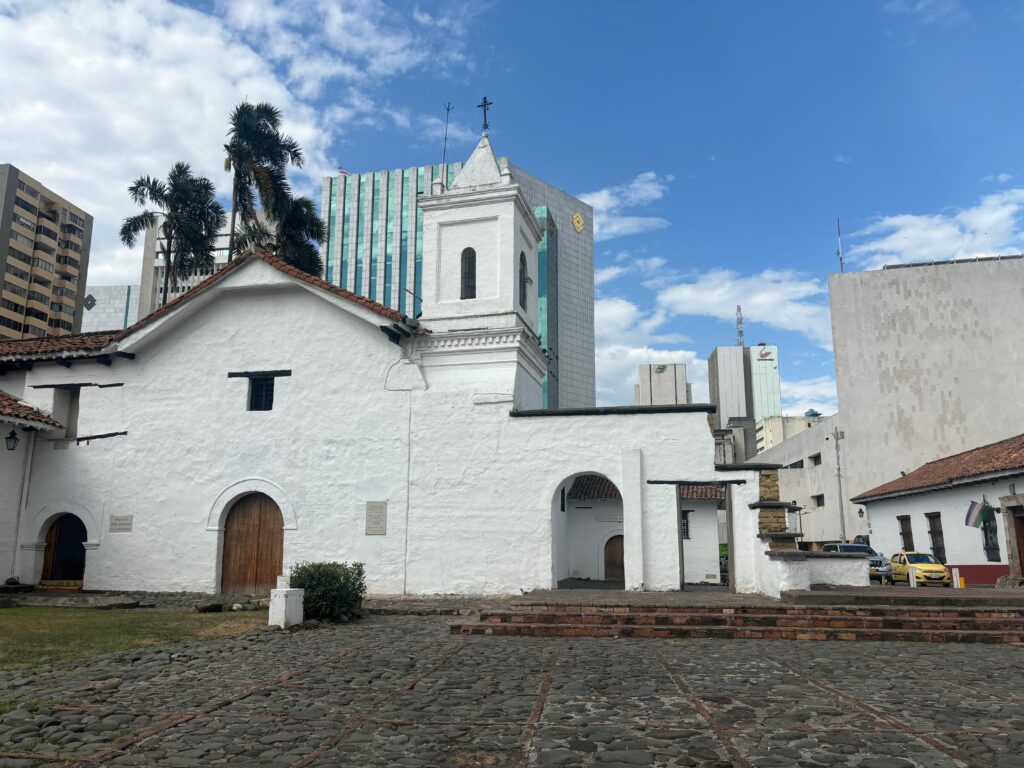
9. Cali Zoo: Considered one of the best zoos in Latin America, Cali Zoo is home to a wide variety of animals, including many native to Colombia. The well maintained zoo is set in a lush, natural environment and is a great place to learn about the region’s biodiversity.
10. Parque del Perro: A popular park in the San Fernando neighborhood, known for its lively atmosphere, surrounded by cafes, bars, and restaurants. The park is a gathering spot for locals, especially in the evenings when the area comes alive with music and street performers.
11. Farallones de Cali: Just outside the city lies the Farallones de Cali, a national park offering a range of outdoor activities including hiking, bird watching, and river swimming. The park’s rugged mountains and diverse ecosystems make it a popular destination for nature enthusiasts.
12. Cristo Rey: Tricky to get to but well worth it for the views and hiking, this 26 metre (85 foot) statue of sits on a hill overlooking the city.
Food
I found Cali’s culinary scene is as vibrant as its nightlife! Try:
- Sancocho de Gallina: A traditional chicken soup made with plantains, yucca, and corn, typically served with rice and avocado.
- Empanadas Vallunas: A local version of empanadas, made with a corn-based dough and stuffed with seasoned meat, potatoes, and onions.
- Pandebono: A popular cheese bread that’s a must-try snack, often enjoyed with a cup of coffee.
- Arroz Atollado: A rich, hearty rice dish made with pork, chicken, and sausage, often served with a fried egg on top.
- Cholado: A refreshing dessert made with shaved ice, fresh fruit, condensed milk, and syrups, -perfect for cooling down on a hot day.
Coffee Adventures
Cali may not be as famous as Bogotá or Medellín for its coffee culture, but I found it offered plenty of opportunities to enjoy some of Colombia’s finest brews with lots of high-quality, locally sourced coffee.
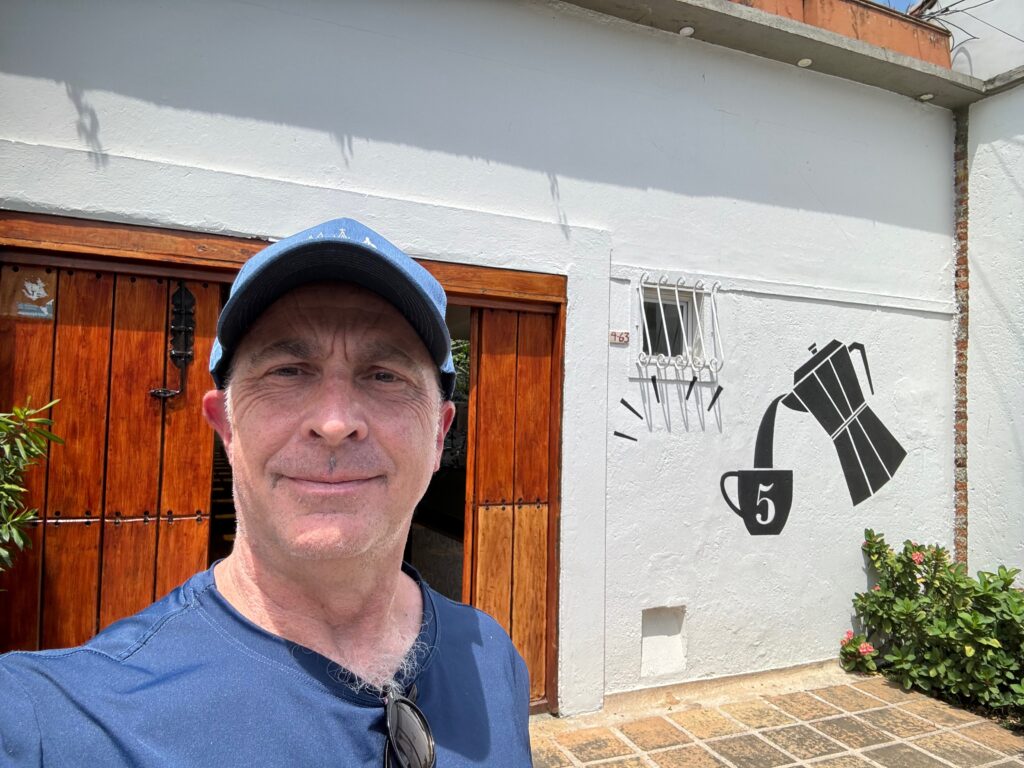
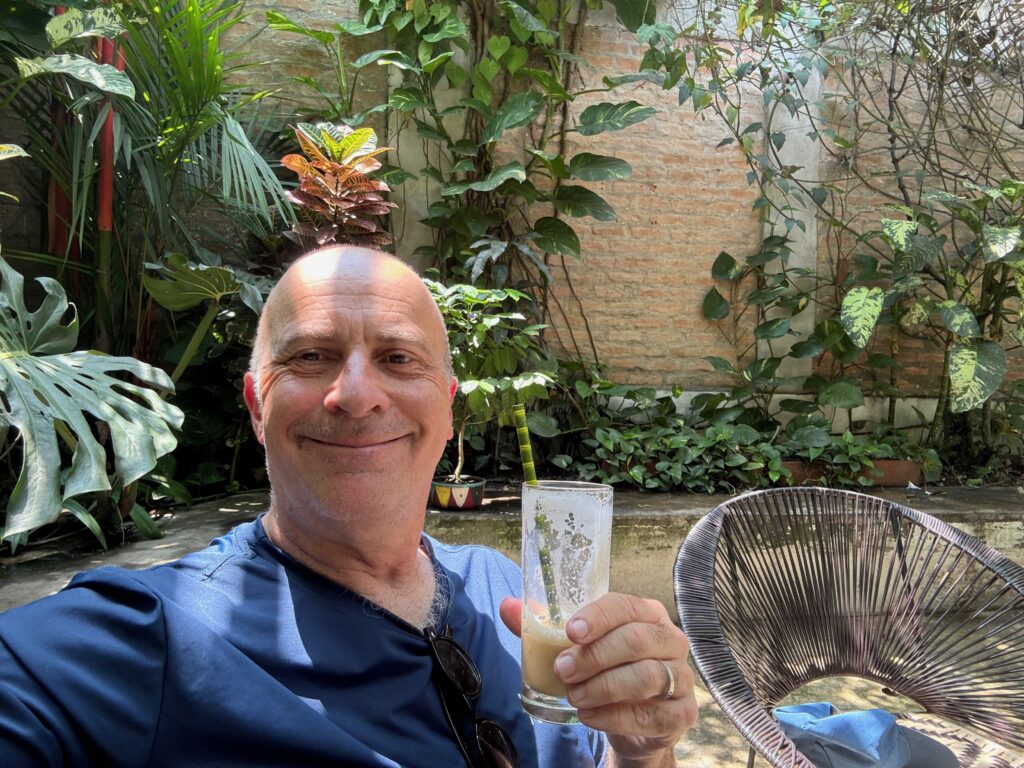
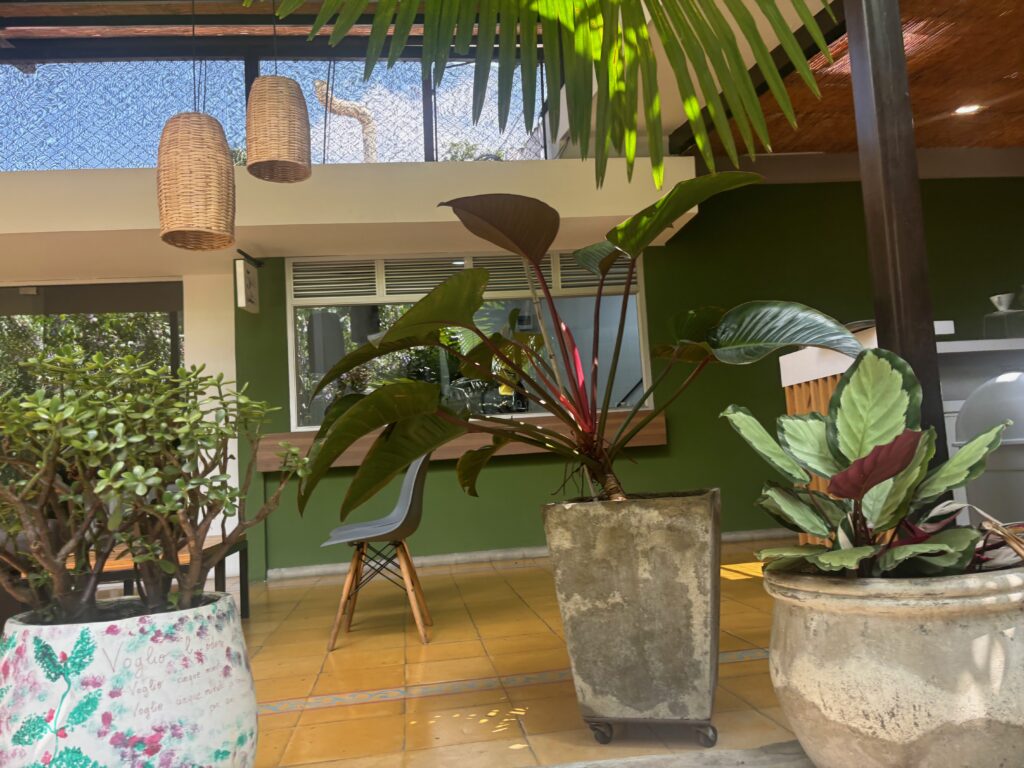
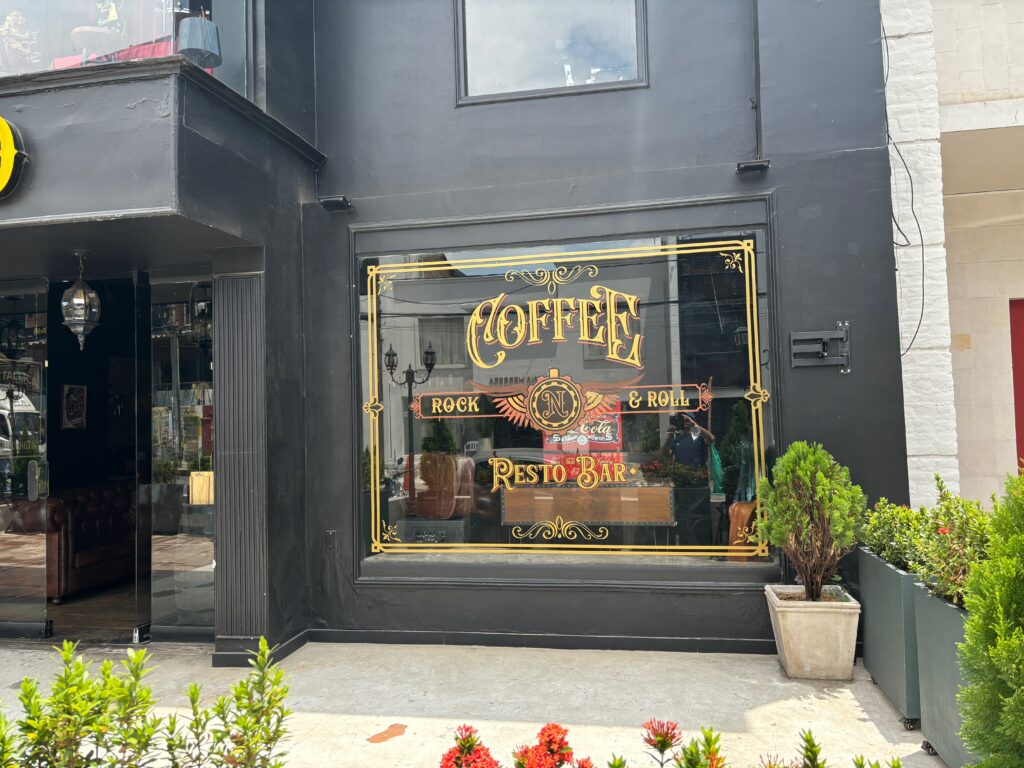
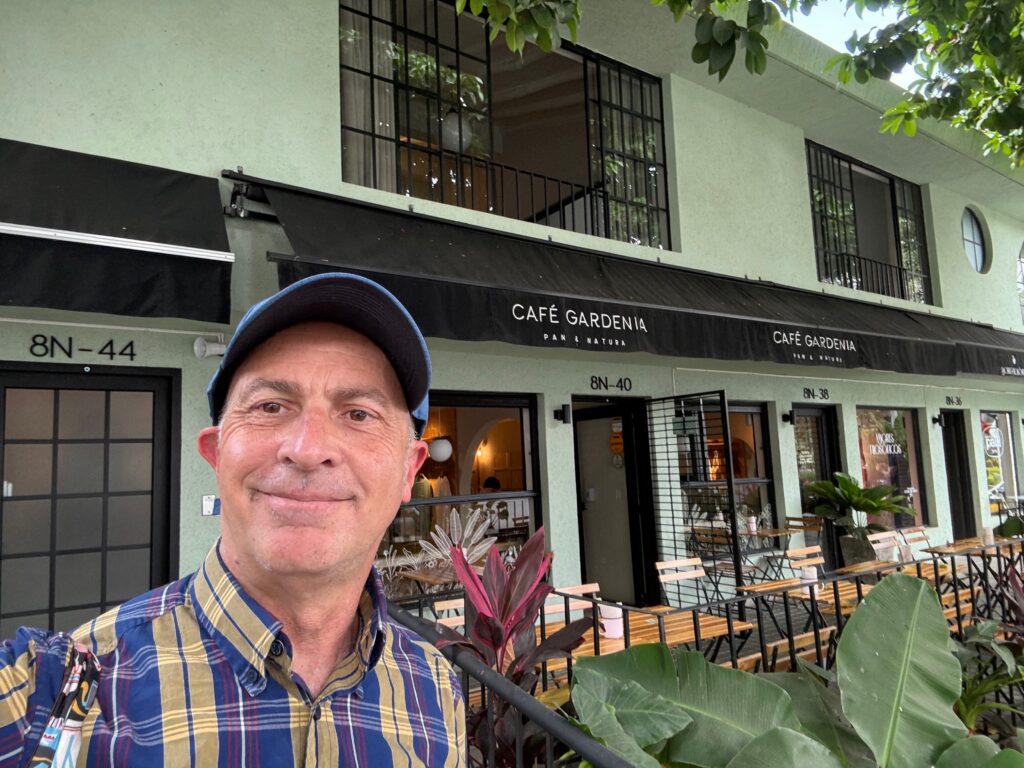
Crime and Safety
Cali, has too much crime. While it has made significant strides in improving safety, certain areas of the city are still plagued by high crime rates, particularly related to petty theft and street crime.
We visitors were constantly warned to stay vigilant, especially in crowded areas and when using public transportation. The usual issues with not displaying valuables and being cautious when walking at night, applied. Despite these challenges, many parts of Cali are perfectly safe for tourists, especially in well-frequented areas.
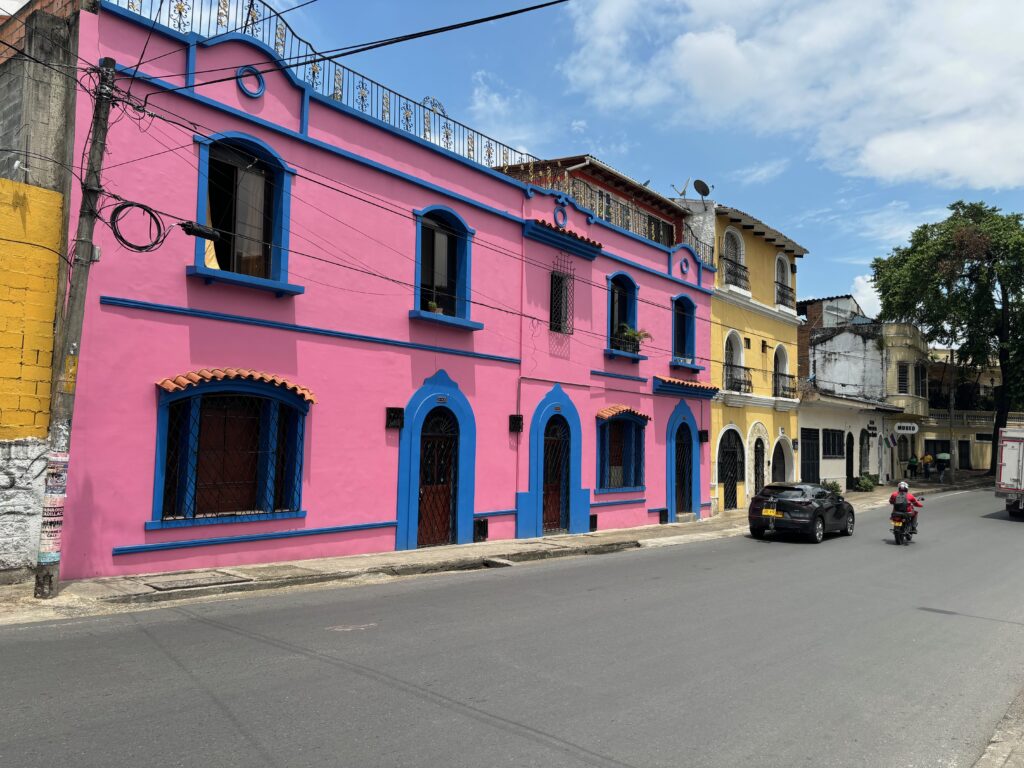
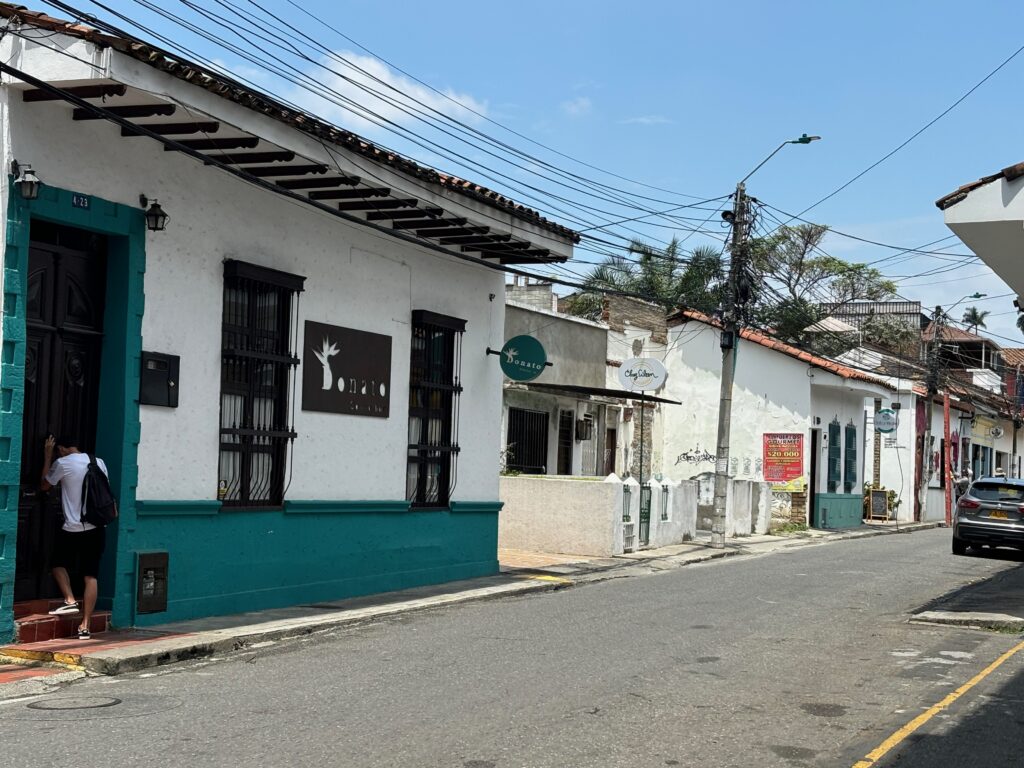
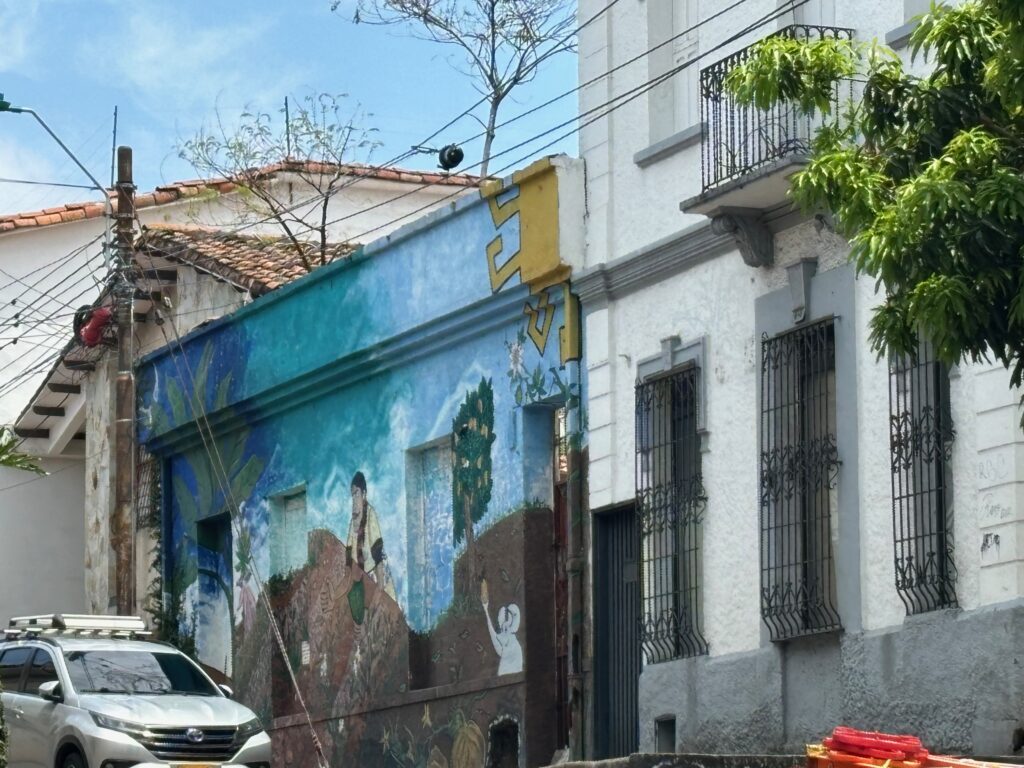
Climate and Weather
At about 1,000 metres (3,280 feet) above sea level, the city enjoys a tropical savanna (not hot) climate, making it one of Colombia’s more pleasant places to live. Cali’s stable year-round temperature, typically ranges from 19°C to 30°C (66°F to 86°F). The city experiences a rainy season from March to May and again from October to November, with the rest of the year being fairly dry.
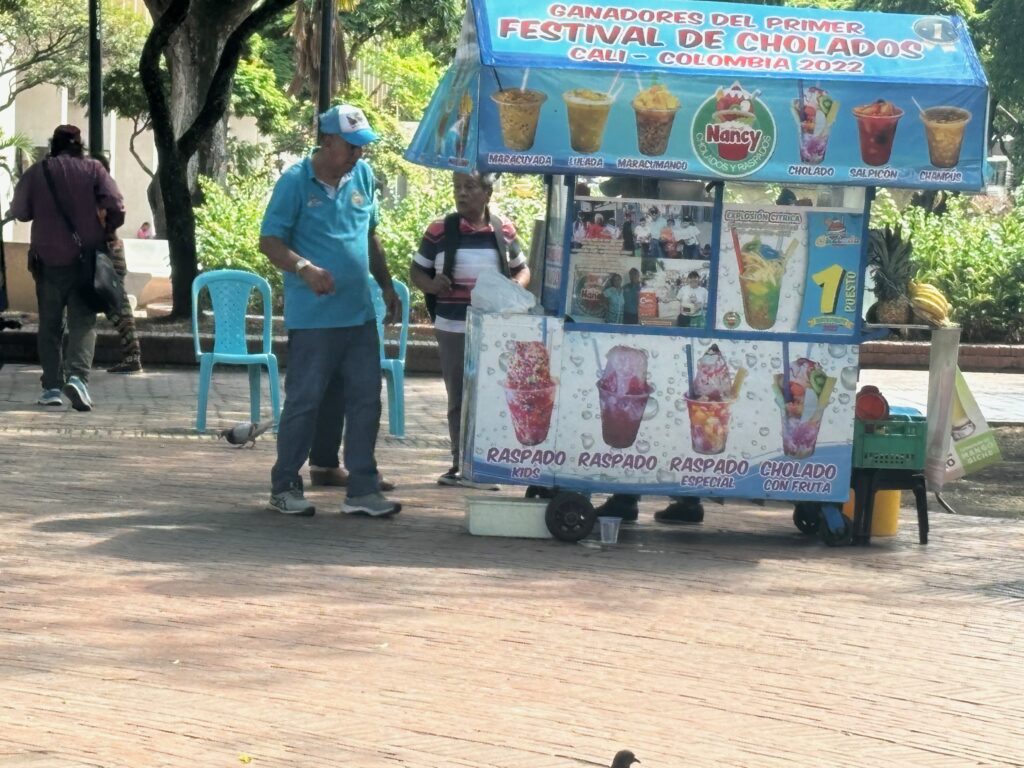
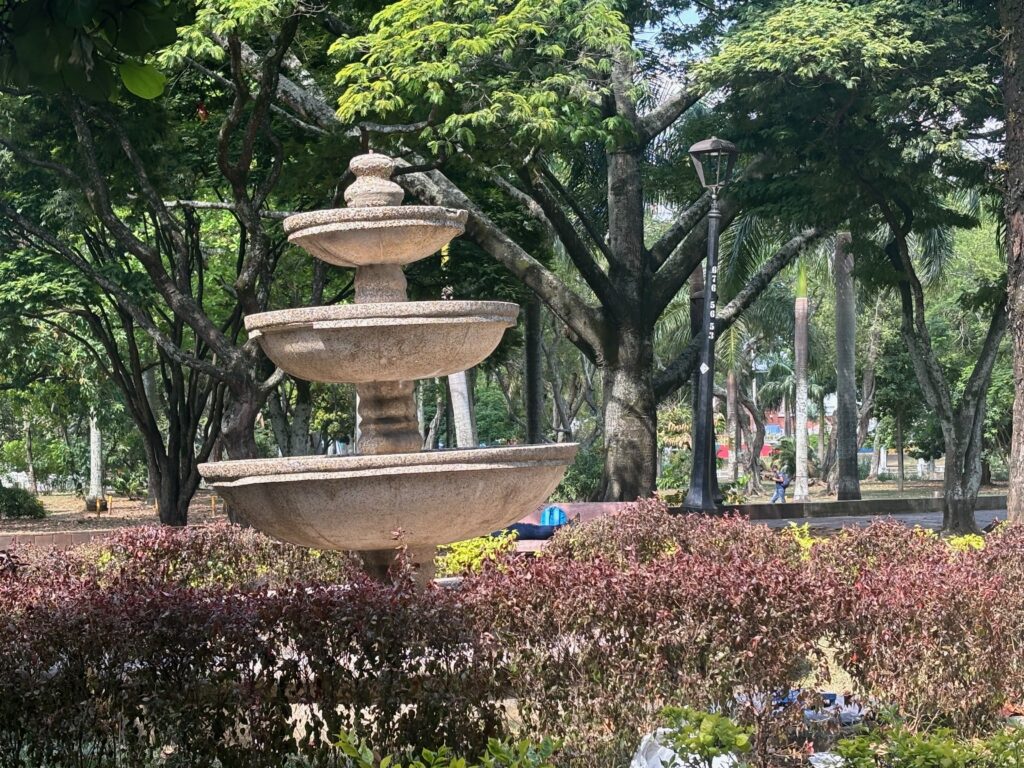
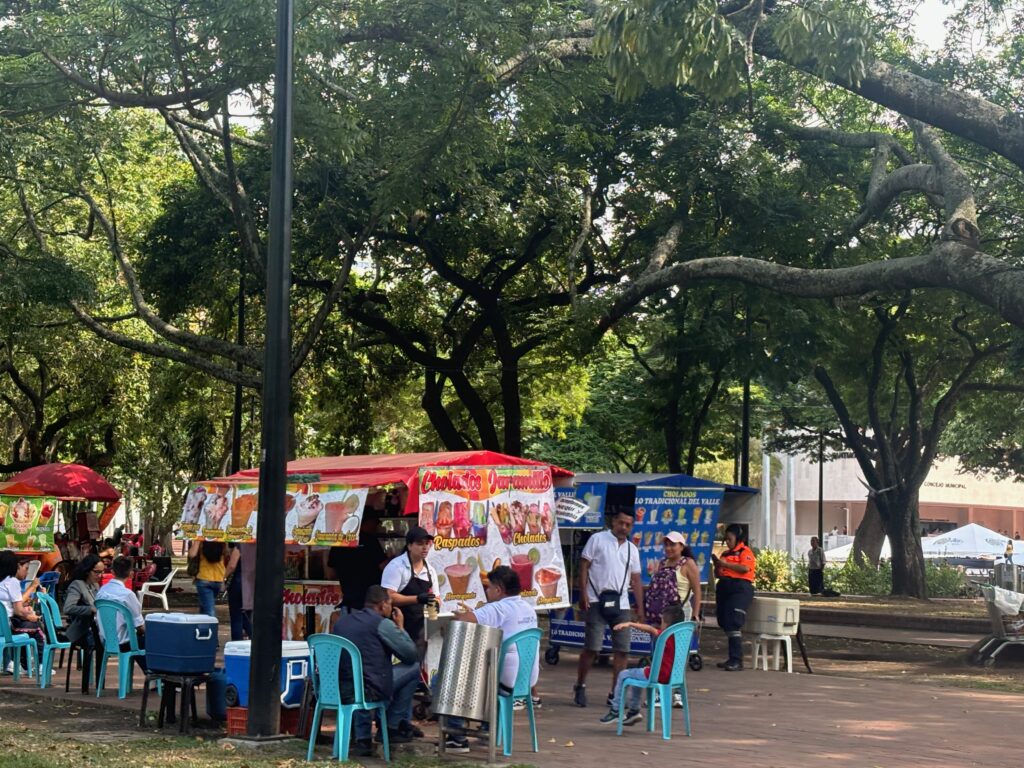
Costs
Cali is an affordable city by international standards, though costs can vary depending on lifestyle and location. Here’s a general idea:
- A meal in an inexpensive restaurant costs around COP 10,000 to 20,000 ($3 to $5 USD).
- Mid-range restaurants typically cost between COP 40,000 to 70,000 ($10 to $18 USD).
- Four-star hotels range from $50 to $100 USD per night.
- A five-kilometre (three-mile) taxi ride costs around $2 USD.
I was unsure about coming to Cali and very sad to leave!
Related Posts
- Bogotá: Bold, Beautiful and Boggling Contrasts
- Santiago: The Heart of Chile
- Under Rated Spokane -16 Top Things for a Great Visit
- Whimsical Portmeirion, Home of “The Prisoner”
- Canterbury: Historic Gem of Southern England
- Stupendous Shanghai
- One Amazing Travel Year: Countless Stories across 23 Countries, 60 Cities


Leave a Reply